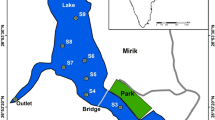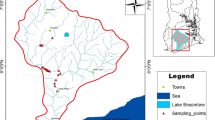Abstract
Purpose
Submerged macrophytes have an ability to absorb metals and metalloids either from the sediments via the roots, from the water by the leaves, or from both sources. The objectives of this study were (1) to test the hypothesis that metal and metalloid concentrations in water and sediments from sampling sites with submerged macrophytes are significantly lower than those from sampling sites without submerged macrophytes, (2) to explore the accumulation potential for metals and metalloids of different submerged macrophyte species, and (3) to discuss the relationships among submerged macrophytes, water, and sediments in the Yunnan Plateau lakes.
Materials and methods
Twenty Yunnan Plateau lakes with different trophic levels were selected. Concentrations of 16 metals and metalloids (Al, As, Ba, Cd, Co, Cr, Cu, Fe, Li, Mn, Mo, Ni, Pb, Se, Sr, and Zn) in submerged macrophytes, water, and sediments were determined by using ICP-AES. Relationships among metal and metalloid concentrations in water, sediments, and submerged macrophytes were carried out by Pearson correlation analysis. The enrichment factor was calculated as the ratio between the concentration of metals and metalloids in a sediment sample and the soil background value.
Results and discussion
No significant differences were found in metal and metalloid concentrations in water and sediments between sampling sites with submerged macrophytes and sampling sites without submerged macrophytes. Moreover, lake water and sediments were mainly contaminated by As, Cr, and Pb. Potamogeton distinctus is a hyperaccumulator of Fe according to the threshold value for Fe hyperaccumulation. Many significantly positive correlations were found among metals and metalloids in submerged macrophytes due to co-accumulation. We found significant correlation between Cr in submerged macrophytes and Cr in water, and strong positive correlations between As, Cd, and Cu in submerged macrophytes and As, Cd, and Cu in corresponding sediments in the Yunnan Plateau lakes.
Conclusions
Submerged macrophytes have no significant effects on metal and metalloid concentrations in sediments and water in all the 20 Yunnan Plateau lakes in the study. However, further studies are necessary to understand the interactions of metals and metalloids in submerged macrophytes, water, and sediments.


Similar content being viewed by others
References
Audry S, Schafer J, Blanc G, Jouanneau JM (2004) Fifty-year sedimentary record of heavy metal pollution (Cd, Zn, Cu, Pb) in the Lot River reservoirs (France). Environ Pollut 132:413–426
Azizur Rahman M, Hasegawa H (2012) Arsenic in freshwater systems: influence of eutrophication on occurrence, distribution, speciation, and bioaccumulation. Appl Geochem 27:304–314
Bai J, Cui B, Chen B, Zhang K, Deng W, Gao H, Xiao R (2011) Spatial distribution and ecological risk assessment of heavy metals in surface sediments from a typical plateau lake wetland, China. Ecol Model 222:301–306
Cheung KC, Poon BHT, Lan CY, Wong MH (2003) Assessment of metal and nutrient concentrations in river water and sediment collected from the cities in the Pearl River Delta, South China. Chemosphere 52:1431–1440
Clabeaux BL, Navarro DA, Aga DS, Bisson MA (2011) Cd tolerance and accumulation in the aquatic macrophyte, Chara australis: potential use for charophytes in phytoremediation. Environ Sci Technol 45:5332–5338
Cullen WR, Reimer KJ (1989) Arsenic speciation in the environment. Chem Rev 89:713–764
De Jonge M, Van de Vijuer B, Blust R, Bervoets L (2008) Responses of aquatic organisms to metal pollution in a lowland river in Flanders: a comparison of diatoms and macroinvertebrates. Sci Total Environ 407:615–629
Demirezen D, Aksoy A (2004) Accumulation of heavy metals in Typha angustifolia (L.) and Potamogeton pectinatus (L.) living in Sultan Marsh (Kayseri, Turkey). Chemosphere 56:685–696
Dirilgen N (2001) Accumulation of heavy metals in freshwater organisms: assessment of toxic interactions. Turk J Chem 25:173–180
Förstner U, Wittmann GT (2012) Metal pollution in the aquatic environment. Springer Science & Business Media, Berlin
Fritioff Å, Kautsky L, Greger M (2005) Influence of temperature and salinity on heavy metal uptake by submersed plants. Environ Pollut 133:265–274
Galbraith LM, Burns CW (2007) Linking land-use, water body type and water quality in southern New Zealand. Landsc Ecol 22:231–241
Greger M, Kautsky L (1993) Use of macrophytes for mapping bioavailable heavy metals in shallow coastal areas, Stockholm, Sweden. Appl Geochem 8:37–43
Hansel CM, Fendorf S, Sutton S, Newville M (2001) Characterization of Fe plaque and associated metals on the roots of mine-waste impacted aquatic plants. Environ Sci Technol 35:3863–3868
Hassan S, Schmieder K, Böcker R (2010) Spatial patterns of submerged macrophytes and heavy metals in the hypertrophic, contaminated, shallow reservoir Lake Qattieneh/Syria. Limnologica 40:54–60
Hawrylak-Nowak B, Kalinowska M, Szymańska M (2012) A study on selected physiological parameters of plants grown under lithium supplementation. Biol Trace Elem Res 149:425–430
Ikem A, Egiebor NO, Nyavor K (2003) Trace elements in water, fish and sediment from Tuskegee Lake, southeastern USA. Water Air Soil Poll 149:51–75
Landis WG, Sofield RM, Yu MH (2010) Introduction to environmental toxicology: molecular substructures to ecological landscapes. CRC Press, Boca Raton
Li Y, Wang H, Wang H, Yin F, Yang X, Hu Y (2014) Heavy metal pollution in vegetables grown in the vicinity of a multi-metal mining area in Gejiu, China: total concentrations, speciation analysis, and health risk. Environ Sci Pollut Res 21:12569–12582
Ma LQ, Komar KM, Tu C, Zhang W, Cai Y, Kennelley ED (2001) A fern that hyperaccumulates arsenic. Nature 409:579–579
Mishra VK, Upadhyay AR, Pandey SK, Tripathi BD (2008) Concentrations of heavy metals and aquatic macrophytes of Govind Ballabh Pant Sagar an anthropogenic lake affected by coal mining effluent. Environ Monit Assess 141:49–58
Monferrán MV, Pignata ML, Wunderlin DA (2012) Enhanced phytoextraction of chromium by the aquatic macrophyte Potamogeton pusillus in presence of copper. Environ Pollut 161:15–22
Newete SW, Erasmus BFN, Weiersbye IM, Byrne MJ (2016) Sequestration of precious and pollutant metals in biomass of cultured water hyacinth (Eichhornia crassipes). Environ Sci Pollut Res 23:20805–20818
Peng K, Luo C, Lou L, Li X, Shen Z (2008) Bioaccumulation of heavy metals by the aquatic plants Potamogeton pectinatus L. and Potamogeton malaianus Miq. and their potential use for contamination indicators and in wastewater treatment. Sci Total Environ 392:22–29
Pilon-Smits E (2005) Phytoremediation. Ann Rev Plant Biol 56:15–39
Rahman MA, Hasegawa H (2011) Aquatic arsenic: phytoremediation using floating macrophytes. Chemosphere 83:633–646
Rai PK (2009) Heavy metals in water, sediments and wetland plants in an aquatic ecosystem of tropical industrial region, India. Environ Monit Assess 158:433–457
Reeves RD, Baker AJM (2000) Metal-accumulating plants. In: Raskin I, Ensley BD (eds) Phytoremediation of toxic metals: using plants to clean up the environment. John Wiley and Sons, New York, pp 193–229
Salas-Luevano MA, Vega-Carrillo HR (2016) Environmental impact in a rural community due to a lead recycling plant in Zacatecas, Mexico. Environ Earth Sci 75:1–9
SEPAC (1990) The background values of soil elements of China. Environmental Science Press of China, Beijing
Sinha RK, Herat S, Tandon PK (2007) Phytoremediation: role of plants in contaminated site management. Book of environmental bioremediation technologies. Springer-Verlag, Berlin
Soltan ME, Rashed MN (2003) Laboratory study on the survival of water hyacinth under several conditions of heavy metal concentrations. Adv Environ Res 7:321–334
Srivastava S, Mishra S, Dwivedi S, Tripathi RD (2010) Role of thiol metabolism in arsenic detoxification in Hydrilla verticillata (L.f.) Royle. Water Air Soil Poll 212:155–165
Tangahu BV, Sheikh Abdullah SR, Basri H, Idris M, Anuar N, Mukhlisin M (2011) A review on heavy metals (As, Pb, and Hg) uptake by plants through phytoremediation. Int J Chem Eng 2011:1–31
Wang Z, He B, Pan X, Zhang K, Wang C, Sun J, Yun Z, Jiang G (2010) Levels, trends and risk assessment of arsenic pollution in Yangzonghai Lake, Yunnan Province, China. Sci China Chem 53:1809–1817
Wang Z, Yao L, Liu G, Liu W (2014) Heavy metals in water, sediments and submerged macrophytes in ponds around the Dianchi Lake, China. Ecotox Environ Safe 107:200–206
Xing W, Huang W, Liu G (2010a) Effect of excess iron and copper on physiology of aquatic plant Spirodela polyrrhiza (L.) Schleid. Environ Toxicol 25:103–112
Xing W, Li D, Liu G (2010b) Antioxidative responses of Elodea nuttallii (Planch.) H. St. John to short-term iron exposure. Plant Physiol Bioch 48:873–878
Xing W, Wu H, Hao B, Huang W, Liu G (2013a) Bioaccumulation of heavy metals by submerged macrophytes: looking for hyperaccumulators in eutrophic lakes. Environ Sci Technol 47:4695–4703
Xing W, Wu H, Hao B, Liu G (2013b) Metal accumulation by submerged macrophytes in eutrophic lakes at the watershed scale. Environ Sci Pollut Res 20:6999–7008
Xing W, Wu H, Shi Q, Hao B, Liu H, Wang Z, Liu G (2015) Multielement stoichiometry of submerged macrophytes across Yunnan Plateau lakes (China). Sci Rep 5:10186
Xing W, Wu H, Hao B, Liu H, Liu G (2017) Trace element stoichiometry of submerged macrophytes in Yangtze floodplain lakes and Yunnan Plateau lakes (China). Aquat Sci 79:89–98
Yang J, Chen L, Liu LZ, Shi WL, Meng XZ (2014) Comprehensive risk assessment of heavy metals in lake sediment from public parks in Shanghai. Ecotox Environ Safe 102:129–135
Yu T, Zhang Y, Hu X, Meng W (2012) Distribution and bioaccumulation of heavy metals in aquatic organisms of different trophic levels and potential health risk assessment from Taihu Lake, China. Ecotox Environ Safe 81:55–64
Zeng H, Wu J (2013) Heavy metal pollution of lakes along the mid-lower reaches of the Yangtze River in China: intensity, sources and spatial patterns. Int J Environ Res Public Health 10:793–807
Zhang Y, Shi T, Zhang Y, Yu T (2014) Spatial distribution and risk assessment of heavy metals in sediments from a hypertrophic plateau lake Dianchi, China. Environ Monit Assess 186:1219–1234
Acknowledgments
This study was supported by National Natural Science Foundation of China (31370479) and National Science and Technology Major Project of China (2012ZX07103003, 2013ZX07102005).
Author information
Authors and Affiliations
Corresponding author
Ethics declarations
Conflict of interest
The authors declare that they have no conflict of interest.
Additional information
Responsible editor: Sabine Ulrike Gerbersdorf
Rights and permissions
About this article
Cite this article
Xing, W., Bai, G., Wu, H. et al. Effect of submerged macrophytes on metal and metalloid concentrations in sediments and water of the Yunnan Plateau lakes in China. J Soils Sediments 17, 2566–2575 (2017). https://doi.org/10.1007/s11368-017-1731-3
Received:
Accepted:
Published:
Issue Date:
DOI: https://doi.org/10.1007/s11368-017-1731-3




